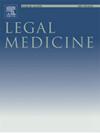从证据到证据:三维重建在犬咬伤法医分析中的应用
IF 1.4
4区 医学
Q3 MEDICINE, LEGAL
引用次数: 0
摘要
在法医科学中,三维(3D)重建技术的使用与创伤性损伤的记录和分析越来越相关。这种方法提供了一种创新的、非侵入性的、精确的和可重复的方法,特别适合于司法环境中的证据目的。本研究提出了两起疑似因狗袭击而死亡的法医案例,其中重建了3D模型,以分析受害者身上发现的咬伤,目的是将它们与其他物种造成的咬痕区分开来。具体而言,使用Dexis 3600口腔内扫描仪进行数据采集,使用Agisoft Metashape软件进行摄影测量处理,使用Geomagic Control X进行三维分析。在第一例病例中,分析了5个咬伤;在第二个病例中,检查了十个病变。结果表明,在法医和法医牙科学实践中,三维扫描与摄影测量相结合可以显著提高动物咬痕评估的准确性。这种整合为识别病变类型和将损伤归因于特定动物物种以及重建攻击的整体动态提供了客观支持-这是法医专家分析的重要方面。本文章由计算机程序翻译,如有差异,请以英文原文为准。
From evidence to proof: case series application of 3d reconstructions in forensic analysis of dog bite injuries
The use of three-dimensional (3D) reconstruction technologies in forensic science is gaining increasing relevance for the documentation and analysis of traumatic injuries. This approach provides an innovative, non-invasive, precise, and reproducible method that is particularly well-suited for evidentiary purposes in judicial contexts.
This study presents two forensic cases of suspected death from dog attacks, in which 3D models were reconstructed to analyze bite-related injuries identified on the victims’ bodies, with the aim of distinguishing them from bite marks caused by other species. Specifically, the Dexis 3600 intraoral scanner was used for data acquisition, Agisoft Metashape software was employed for photogrammetric processing and Geomagic Control X was utilized for 3D analysis. In the first case, five bite wounds were analyzed; in the second case, ten lesions were examined.
The findings demonstrate that the integration of 3D scanning and photogrammetry in forensic and forensic odontology practice can significantly enhance the accuracy of animal bite mark assessment. This integration provides objective support in both identifying the lesion typology and attributing the injuries to a specific animal species, as well as reconstructing the overall dynamics of the attack − an essential aspect of forensic expert analysis.
求助全文
通过发布文献求助,成功后即可免费获取论文全文。
去求助
来源期刊

Legal Medicine
Nursing-Issues, Ethics and Legal Aspects
CiteScore
2.80
自引率
6.70%
发文量
119
审稿时长
7.9 weeks
期刊介绍:
Legal Medicine provides an international forum for the publication of original articles, reviews and correspondence on subjects that cover practical and theoretical areas of interest relating to the wide range of legal medicine.
Subjects covered include forensic pathology, toxicology, odontology, anthropology, criminalistics, immunochemistry, hemogenetics and forensic aspects of biological science with emphasis on DNA analysis and molecular biology. Submissions dealing with medicolegal problems such as malpractice, insurance, child abuse or ethics in medical practice are also acceptable.
 求助内容:
求助内容: 应助结果提醒方式:
应助结果提醒方式:


